What do skinks eat?
What Do Skinks Eat?
Skinks are fascinating reptiles known for their adaptability and diverse diets. Understanding what do skinks eat is essential for anyone interested in these unique lizards. Their diets can vary significantly based on their species and habitat, with most skinks being primarily insectivorous.
In their natural environments, skinks typically hunt a variety of insects and other small invertebrates. However, they are also known to consume fruits and vegetables, especially when insects are less available. This adaptability helps them thrive in various conditions, making them interesting subjects for study and pet ownership.
What insects do skinks eat?
Insects comprise a substantial portion of the skink diet. These lizards are known to hunt and consume various insects, which provide essential nutrients for their growth and health. Common insects that skinks eat include:
- Crickets
- Beetles
- Spiders
- Ants
- Moths
When considering what do skinks eat, it’s important to note that the availability of these insects often varies by season and location. In warm months, skinks may feed more frequently on a bounty of insects, while in cooler periods, their diet may shift.
Some species of skinks, particularly those in captivity, may also benefit from a diverse diet that includes various insect types. This ensures they receive a wide range of nutrients necessary for optimal health.
What fruits can skinks eat?
Fruits can also be a beneficial addition to a skink’s diet, providing hydration and essential vitamins. Some fruits that are safe for skinks to consume include:
- Melon
- Blueberries
- Strawberries
- Bananas
- Mango
It’s important for skink owners to ensure that any fruit provided is chopped into small, manageable pieces. This makes it easier for skinks to eat and digest. Moreover, offering a variety of fruits can help prevent boredom and encourage a healthy appetite.
When determining what do skinks eat, it’s essential to balance their diet with both insects and fruits. This combination can lead to healthier, more active lizards.
What vegetables are safe for skinks?
In addition to fruits, certain vegetables can also be included in a skink’s diet. Safe options for skinks include:
- Carrots
- Leafy greens (like kale and romaine lettuce)
- Squash
- Cucumber
- Bell peppers
Incorporating vegetables into a skink’s diet can provide additional nutrients and fiber. Just like with fruits, vegetables should be chopped into small pieces to facilitate easy feeding. Skinks tend to enjoy a variety of textures and flavors, making it beneficial for their diet.
Offering both vegetables and fruits can help in replicating a more natural diet, which is crucial for keeping skinks healthy in captivity.
How to replicate a natural diet for skinks?
Replicating a natural diet for skinks is vital for their well-being. A proper balance of insects, fruits, and vegetables is necessary to mimic their natural feeding habits. Here are some tips for skink owners:
- Offer a variety of live insects to provide essential protein. Crickets and mealworms are excellent choices.
- Include chopped fruits and vegetables to ensure they receive the necessary vitamins and hydration.
- Consider commercial reptile diets that are specifically formulated for skinks, supplementing their natural feeding.
- Ensure that all food is fresh and free from pesticides or chemicals.
- Monitor their eating habits and adjust the diet as necessary based on their preferences and health.
Skinks are generally opportunistic feeders; therefore, providing a diverse diet will help maintain their interest and health. Regularly changing the types of insects and produce offered can enhance their feeding experience.
How often should you feed your skink?
The frequency of feeding skinks can vary based on several factors such as their age, size, and overall health. Generally, younger skinks require more frequent feedings compared to adults. Here are some guidelines:
Juvenile skinks typically should be fed every day, as they are growing rapidly and require more energy. Adult skinks, on the other hand, may only need to be fed every other day or a few times a week, depending on their activity level and health.
It’s crucial to observe your skink’s body condition and adjust feeding frequency accordingly. Ensuring they receive the right amount of food will help prevent obesity and other health issues.
Are skinks poisonous to humans or pets?
Many people wonder whether skinks pose a danger to humans or other pets. The good news is that skinks are generally not poisonous. They are harmless reptiles that do not possess venom or toxic secretions.
However, skinks can bite if threatened, and while their bites are not dangerous, they can cause minor irritation or discomfort. It’s essential to handle skinks gently and with care to avoid stressing them out.
In summary, skinks are safe to have around humans and other pets. Understanding their dietary needs and behavior can help foster a healthy and safe environment for these fascinating lizards.




